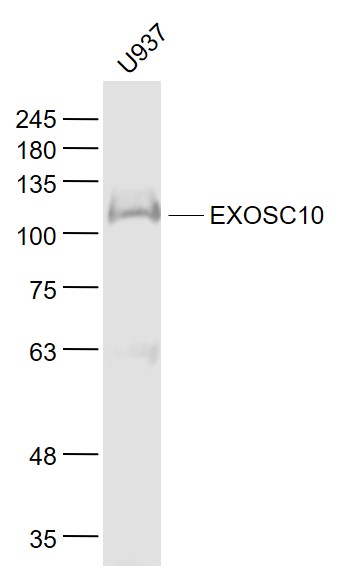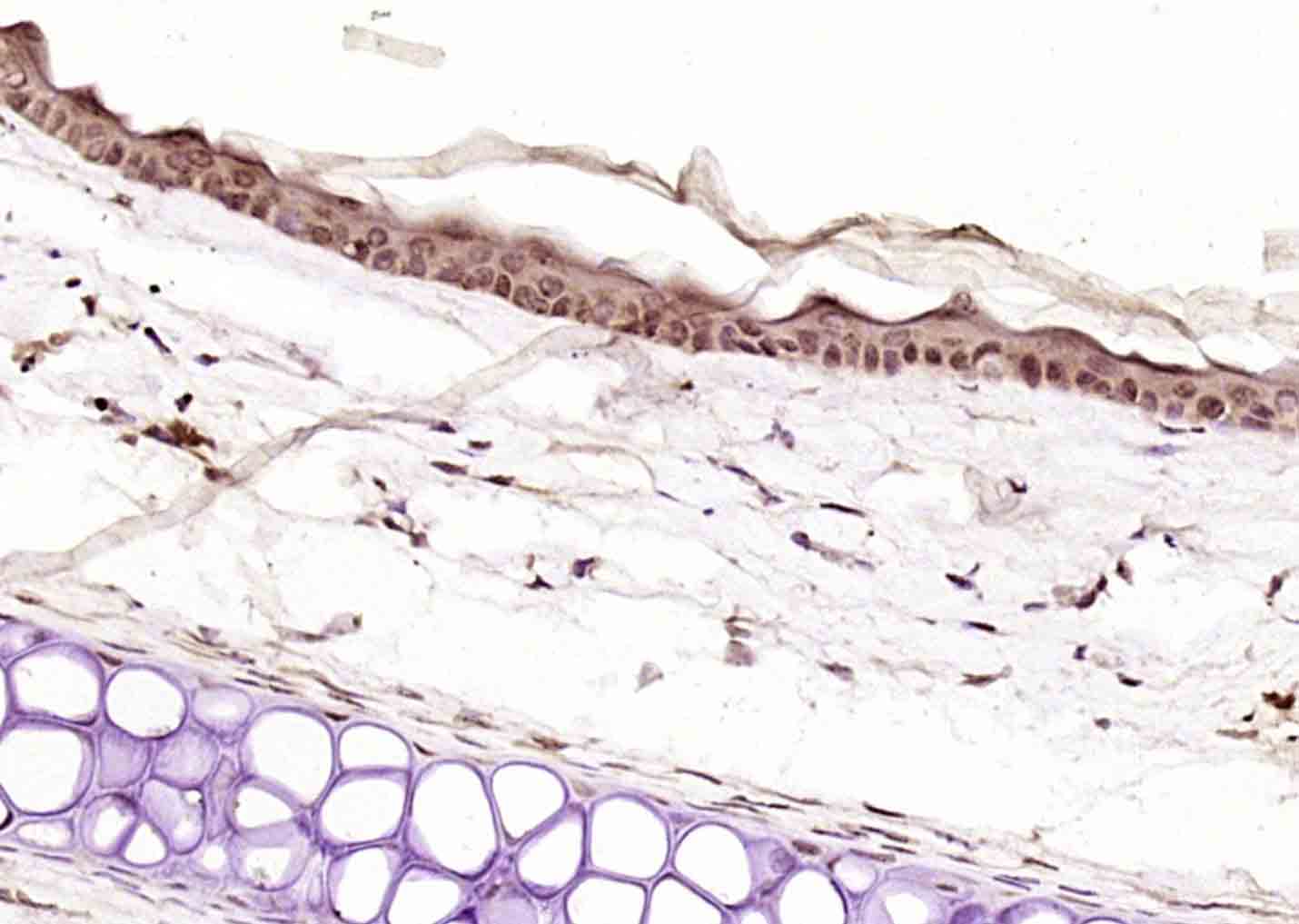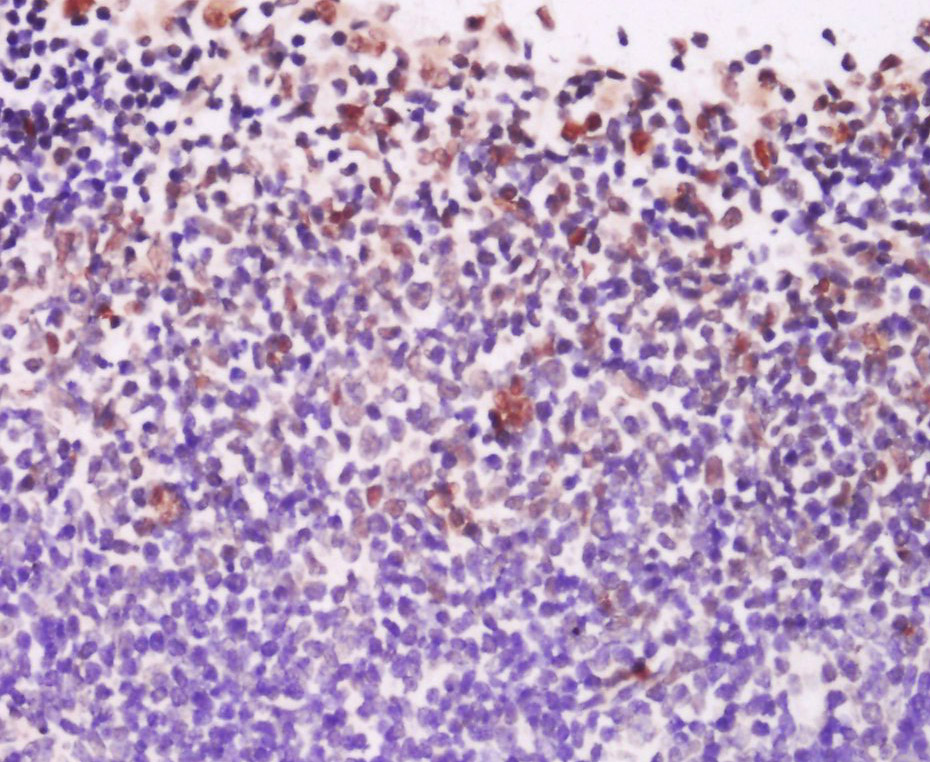
Rabbit Anti-EXOSC10 antibody
Autoantigen PM/Scl 2; Exosc10; Exosome component 10; EXOSX_HUMAN; P100 polymyositis scleroderma overlap syndrome associated autoantigen; P100 polymyositis-scleroderma overlap syndrome-associated autoantigen; p2; p3; p4; PM Scl; PM/Scl 100; PM/Scl-100; PMS
View History [Clear]
Details
Product Name EXOSC10 Chinese Name 多发性肌炎/硬皮病自身抗原2抗体 Alias Autoantigen PM/Scl 2; Exosc10; Exosome component 10; EXOSX_HUMAN; P100 polymyositis scleroderma overlap syndrome associated autoantigen; P100 polymyositis-scleroderma overlap syndrome-associated autoantigen; p2; p3; p4; PM Scl; PM/Scl 100; PM/Scl-100; PMSCL; PMSCL2; Polymyositis/scleroderma autoantigen 100 kDa; Polymyositis/scleroderma autoantigen 2 100 kDa; Polymyositis/scleroderma autoantigen 2; RRP6; Rrp6p. Research Area Cell biology Epigenetics Immunogen Species Rabbit Clonality Polyclonal React Species Human, Mouse, (predicted: Rat, Dog, Pig, Cow, Horse, Sheep, ) Applications WB=1:500-2000 ELISA=1:5000-10000 IHC-P=1:100-500 IHC-F=1:100-500 ICC=1:100-500 IF=1:100-500 (Paraffin sections need antigen repair)
not yet tested in other applications.
optimal dilutions/concentrations should be determined by the end user.Theoretical molecular weight 101kDa Cellular localization The nucleus cytoplasmic Form Liquid Concentration 1mg/ml immunogen KLH conjugated synthetic peptide derived from human EXOSC10/PMSCL2: 41-140/885 Lsotype IgG Purification affinity purified by Protein A Buffer Solution 0.01M TBS(pH7.4) with 1% BSA, 0.03% Proclin300 and 50% Glycerol. Storage Shipped at 4℃. Store at -20 °C for one year. Avoid repeated freeze/thaw cycles. Attention This product as supplied is intended for research use only, not for use in human, therapeutic or diagnostic applications. PubMed PubMed Product Detail The exosome is a multi-subunit complex composed of several highly conserved proteins, some of which are 3’ to 5’ exoribonucleases. The complex is involved in a variety of cellular processes and is responsible for degrading unstable mRNAs that contain AU-rich (ARE) elements in their untranslated 3’ region. EXOSC10, also known as PMSCL, PMSCL2, p2, p3, p4, RRP6, Rrp6p, PM-Scl, or PM/Scl-100, is an 885 amino acid protein that contains one HRDC domain and one 3’-5’ enonuclease domain. Localized to both the cytoplasm and the nucleus, EXOSC10 is part of the post-splicing exosome complex and is involved in mRNA surveillance, mRNA nuclear export and nonsense-mediated decay of mRNAs containing premature stop codons. Antibodies against EXOSC10 have been found in patients with scleroderma and/or polymyositis (chronic diseases of the skin and muscle, respectively), suggesting that EXOSC10 may be involved in the pathogenesis of these diseases. Two isoforms of EXOSC10 exist due to alternative splicing events.
Function:
Putative catalytic component of the RNA exosome complex which has 3'->5' exoribonuclease activity and participates in a multitude of cellular RNA processing and degradation events. In the nucleus, the RNA exosome complex is involved in proper maturation of stable RNA species such as rRNA, snRNA and snoRNA, in the elimination of RNA processing by-products and non-coding 'pervasive' transcripts, such as anti-sense RNA species and promoter-upstream transcripts (PROMPTs), and of mRNAs with processing defects, thereby limiting or excluding their export to the cytoplasm. The RNA exosome may be involved in Ig class switch recombination (CSR) and/or Ig variable region somatic hypermutation (SHM) by targeting AICDA deamination activity to transcribed dsDNA substrates. In the cytoplasm, the RNA exosome complex is involved in general mRNA turnover and specifically degrades inherently unstable mRNAs containing AU-rich elements (AREs) within their 3' untranslated regions, and in RNA surveillance pathways, preventing translation of aberrant mRNAs. It seems to be involved in degradation of histone mRNA. EXOSC10 has 3'-5' exonuclease activity (By similarity). EXOSC10 is required for nucleolar localization of C1D and probably mediates the association of SKIV2L2, C1D and MPP6 wth the RNA exosome involved in the maturation of 5.8S rRNA.
Subunit:
Component of the RNA exosome complex. The catalyticallyinactive RNA exosome core (Exo-9) complex is believed to associatewith catalytic subunits EXOSC10, and DIS3 or DIS3L incytoplasmic-and nuclear-specific RNA exosome complex forms.Interacts with C1D and MPHOSPH6.
Subcellular Location:
Cytoplasm. Nucleus > nucleolus. Nucleus. Strongly enriched in the nucleolus and a small amount has been found in cytoplasm supporting the existence of a nucleolar RNA exosome complex form.
Similarity:
Contains 1 3'-5' exonuclease domain.
Contains 1 HRDC domain.
SWISS:
Q01780
Gene ID:
5394
Database links:Entrez Gene: 5394 Human
Entrez Gene: 50912 Mouse
Omim: 605960 Human
SwissProt: Q01780 Human
SwissProt: P56960 Mouse
Unigene: 632368 Human
Unigene: 266635 Mouse
Product Picture
U937(Human) Cell Lysate at 30 ug
Primary: Anti- EXOSC10 (SL13120R) at 1/1000 dilution
Secondary: IRDye800CW Goat Anti-Rabbit IgG at 1/20000 dilution
Predicted band size: 101 kD
Observed band size: 103 kD
Tissue/cell: human skin tissue; 4% Paraformaldehyde-fixed and paraffin-embedded;
Antigen retrieval: citrate buffer ( 0.01M, pH 6.0 ), Boiling bathing for 15min; Block endogenous peroxidase by 3% Hydrogen peroxide for 30min; Blocking buffer (normal goat serum,C-0005) at 37℃ for 20 min;
Incubation: Anti-EXOSC10, Unconjugated(SL13120R) 1:200, overnight at 4°C, followed by conjugation to the secondary antibody(SP-0023) and DAB(C-0010) staining
Paraformaldehyde-fixed, paraffin embedded (mouse skin); Antigen retrieval by boiling in sodium citrate buffer (pH6.0) for 15min; Block endogenous peroxidase by 3% hydrogen peroxide for 20 minutes; Blocking buffer (normal goat serum) at 37°C for 30min; Antibody incubation with (EXOSC10) Polyclonal Antibody, Unconjugated (SL13120R) at 1:200 overnight at 4°C, followed by operating according to SP Kit(Rabbit) (sp-0023) instructionsand DAB staining.Tissue/cell: Mouse Lymph nodes; 4% Paraformaldehyde-fixed and paraffin-embedded;
Antigen retrieval: citrate buffer ( 0.01M, pH 6.0 ), Boiling bathing for 15min; Block endogenous peroxidase by 3% Hydrogen peroxide for 30min; Blocking buffer (normal goat serum,C-0005) at 37℃ for 20 min;
Incubation: Anti-EXOSC10, Unconjugated(SL13120R) 1:200, overnight at 4°C, followed by conjugation to the secondary antibody(SP-0023) and DAB(C-0010) staining
Bought notes(bought amounts latest0)
No one bought this product
User Comment(Total0User Comment Num)
- No comment






 +86 571 56623320
+86 571 56623320
 +86 18668110335
+86 18668110335

